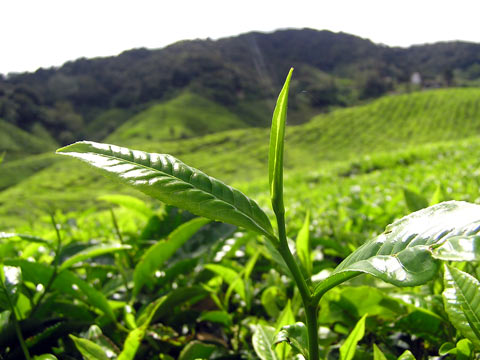I know very little about tea, apart from what you learn by osmosis from your Anglo-Australian grandparents. I can make a decent cup of black tea but tend to regard it as a sort of beverage bycatch; something that fits well alongside pho or yum cha or fruitcake. I have no idea how it is grown, processed or traded in large quantities. I was in Tanah Rata in Malaysia’s Cameron Highlands and this emboldened me to find out.
The general image of smiling, passive locals hand-picking tea that is planted by unscrupulous tea advertisers the world over is as wrong as it is Orientalist. Most of the tea in the Cameron Highlands is semi-mechanically harvested. Two people standing each side of the row of tea drag the above device across the new shoots, which slices and blows the fresh tea into a bag. Less accessible bushes on the mountain peaks and the depths of the ravines are still harvested by hand, but this represents an absolute minority of the total tea produced. In lowland plantations, a modified combine harvester drives over the top of the rows. The tea is allowed to resprout fresh tips that are then reharvested about every three weeks.
Once picked, the leaves are withered, crushed, torn and curled by machine then set aside to oxidise. The oxidation process is called “fermentation” for purely historical reasons as nothing ferments. The tea, now turned from green to black from oxidation, is dried, sorted, tasted and packed.

Hope you stopped for tea at the Lakehouse. Was Cameron Highlands still cool?
Throughout Sri Lanka and India, tea is picked by hand, mostly by women, as it is believed in many areas that only women know the proper, gentle techniques to keep the precious tips intact.
I remember reading somewhere that Sri Lanka was beginning to mechanize some of its production due to labour shortages, but I can’t find the reference. However, I did find this great post from a geography blog on their visit to a Sri Lankan plantation:
“According to the company guide who showed me around, the plantation is 1,200 acres in size, and employs 900 women as tea pickers. I asked my the Mackwoods representative why only women are used as tea pickers. “Because they have more sensitive fingers,” she told me, “which are necessary for picking the buds.” A more plausible explanation came from my guide, Sarath. Women can be paid less than men.
Let’s do some arithmetic here. Each picker picks up to 40 kg of tea a day. According to a 2005 BBC report, workers’ wages depend on how many leaves they can collect, but average wages are about US$60 per month. My guide gave me a somewhat higher figure of $3.50 per day. Using a figure midway between these two would mean that Mackwoods pays something like $2,500 per day in picker’s wages, or about 7c per kilo of tea plucked (this is the weight of the newly plucked leaves; the weight is reduced signficantly during processing.)
If tea were grown in the United States, with pickers earning the minimum wage of $5. 85 an hour, a Mackwood-sized contingent of 900 workers would earn around $42,000 per day, or about $1.17 per kilo of tea picked. At this price, the cost of processed tea to the consumer would be prohibitively high, and tea would price itself out of the market. And because of the peculiar needs of tea cultivation, the possibilities of using mechanization to lower costs are not very great.
In other words, it’s just as well for the world’s tea drinkers that their favorite beverage is produced in poor, tropical countries like Sri Lanka, India, Vietnam, and Tanzania.”
Beautiful pictures.
Ourman – Cheers. It is hard to take a bad shot of a tea plantation in full sunshine. You’ve left Hanoi? I’ve really got to catch up on your website.
“…it’s just as well for the world’s tea drinkers that their favorite beverage is produced in poor, tropical countries …”
… with no OSHA laws, either. Visit a tea factory, and you can’t breathe the air. Lung diseases run high. Furthermore, the pickers I interviewed in Sri Lanka lost large portions of their pay if they didn’t meet the daily quota. Men (working inside the factory) and women (working in the field) both faced these problems.
Meanwhile, the social and economic realities endured by Adavasi tea pickers in Assam, India, (the birthplace of tea, as far as the West is concerned) recently led to bloody riots and killings in the streets. Poverty is an understatement.
Fantastic pics and interesting article, Phil.
However, if there were American tea farmers, they would not be paying pickers $5.85/h, nor concerning themselves with OH&S. That’s what Mexicans are for. Nonetheless, I think the economics still holds.
It turns out that there is one tea plantation in the USA. They use this tea combine harvester to pick it rather than an immigrant workforce, and charge US$129 a kilo for tea at retail. As a point of comparison, Lipton charges US$89 a kilo (on Amazon.com) for their cheapest loose tea.